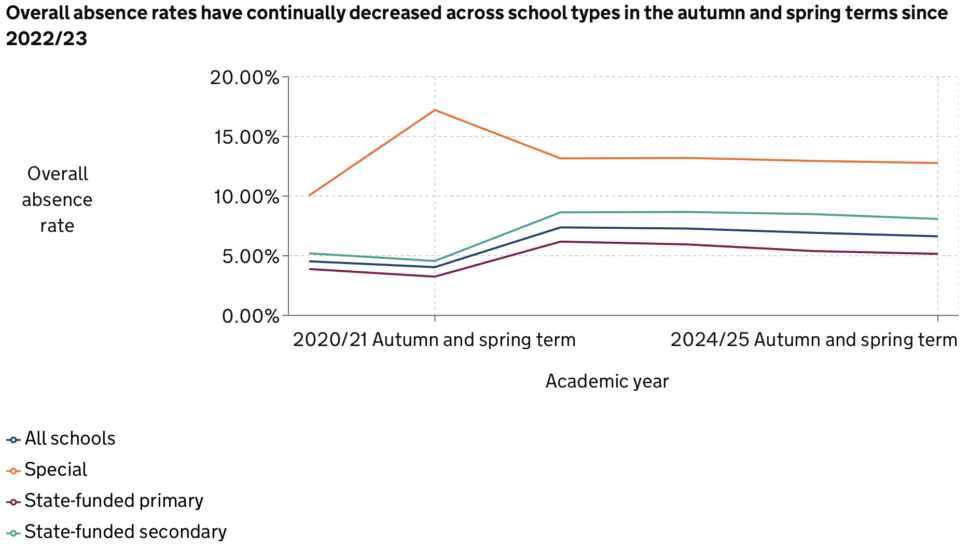Severe absence rates were on the rise again in the last academic year, with higher increases for SEND pupils and those eligible for free school meals.
But government data, published today covering the autumn and spring term 2024-25, show overall absence and persistent absence – when pupils miss 10 per cent of sessions a year – has improved.
However overall attendance rates remain lower than pre-pandemic levels. The Department for Education said interventions on severe absence would “build over time” and “turning it around isn’t going to happen overnight”.
Severe absence on the rise
Severe absence rates rose from 2.14 per cent in autumn and spring 2023-24, to 2.26 per cent in autumn and spring 2024-25. There were rises across all regions, the DfE data shows.
FSM-eligible pupils saw an increase in severe absence from 3.93 per cent to 3.98 per cent, while kids on an education and health care plan had a severe absence rate of 7.3 per cent last year – up from 6.55 per cent the year before.
Pupils with SEN support also saw a rise of severe absence from 4.06 per cent to 4.18 per cent.
Meanwhile, those not eligible for free school meals saw a rise of severe absence from 1.07 per cent to 1.10 per cent. Severe absence rates for pupils with no identified SEN fell from 1.16 per cent to 1.11 per cent
According to analysis from Impetus, children from a disadvantaged background are nearly four times more likely to be severely absent compared to their peers.
The DfE said interventions on severe absence “is something that builds over time”, and “turning it around isn’t going to happen overnight”.
Persistent absence often leads to severe absence, the DfE said, but falling rates of persistent absence means “fewer pupils entering the pipeline” to greater absence.
Improvements elsewhere
But there are improvements in both overall absence and persistent absence rates.
Persistent absence has fallen from 19.23 per cent in autumn and spring 2023-24, to 17.63 per cent in autumn and spring 2024-25.
But this still remains much higher than pre-pandemic levels, where persistent absence was 10.53 per cent in 2018-19.

Overall absence rates have also fallen from 6.93 per cent in autumn and spring 2023-24, to 6.63 per cent in autumn and spring 2024-25.
All regions saw rates of persistent absence fall, while only London saw an increase in overall absence last year.
‘Most difficult part of its inheritance’
The DfE said it is taking action to reduce absence rates, with severe absence the “most difficult part of its inheritance”.
It said free breakfast clubs, attendance and behaviour hubs and school improvement teams will positively impact rates of absence.
A DfE spokesperson said: “The Covid inquiry is laying bare the impact the pandemic had on children and on school absence.
“This government is taking the action needed to get our kids back in school, with the biggest improvement in attendance in a decade last academic year. Absence is down, persistent absence has plummeted and we are slowing the stubborn rise in severe absence.”

Susannah Hardyman, CEO of education charity Impetus, said while absence rates are “moving in the right direction”, attendance “is foundational for future success, and its decline has become the key driver behind some of England’s most pernicious challenges”.
Impetus analysis suggested it will take another four years before persistent absence is back to pre-Covid levels.
Government said its upcoming schools white paper, which has been pushed back to the new year, will further tackle absence.
Emily Wells, Senior Researcher at the Centre for Social Justice, added “teachers, parents and ministers all deserve credit for pushing persistent absence down”, but that data “tells a darker story, which is that a new record in severe absence has been smashed”.







There is an error in the third paragraph that needs correction – However overall attendance rates remain higher than pre-pandemic levels. The Department for Education said interventions on severe absence would “build over time” and “turning it around isn’t going to happen overnight”.
DfE states that overall absences rates are higher, not attendance: “The overall absence rate fell to 6.63% in combined autumn and spring terms 2024/25, down from 6.93% in the previous autumn and spring terms, though still above pre-pandemic levels when they were consistently below 5%.” https://explore-education-statistics.service.gov.uk/find-statistics/pupil-absence-in-schools-in-england/2024-25-autumn-and-spring-term
The government spokesperson mentioned the impact of COVID on attendance – but not the tens of thousands of children severely affected by long COVID who are spiking the severe absence figures. There pretending they don’t exist. Slowly, as they become disabled adults, the figures will improve and the government of the day will take the credit.